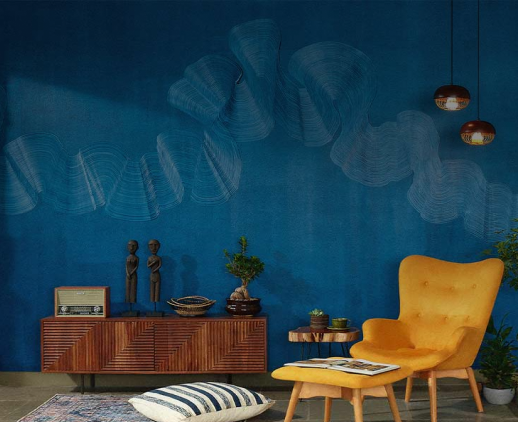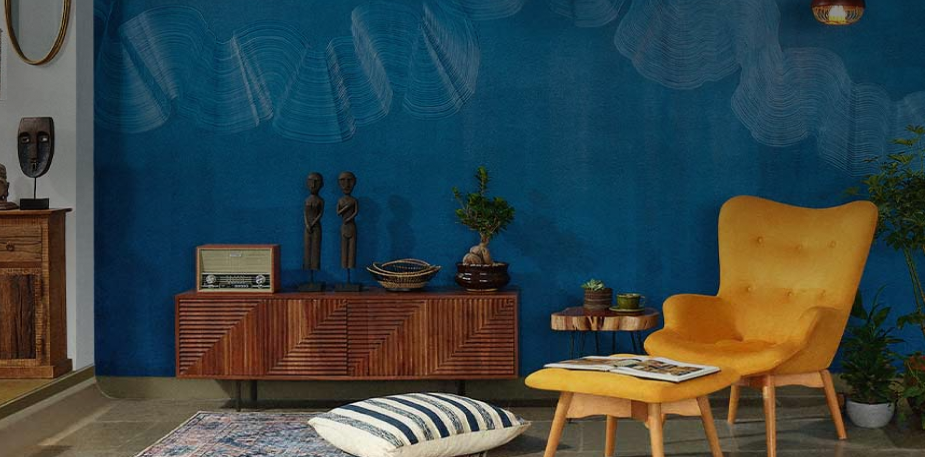Get your home interior design budget estimate
The home of late designer Leela Shiveshwarkar has stood the test of time

Nestled amidst peepal and mango trees and standing resolutely at the junction of two crossroads in the coveted residential neighbourhood of Vasant Vihar in South Delhi, is an impressive two storied white brick structure. Unmistakable, with its distinctive facade and Modernist leanings, the house was conceptualised and built in the late 1960s by furniture designer Leela Shiveshwarkar as a private residence after her husband retired from the ICS and the family decided to settle in Delhi.
Born into a prominent family from Ahmedabad and the daughter of NC Mehta, one of India’s first art collectors, Leela had an in-depth knowledge of Indian art, and an abiding love for its craft forms, traditions and expressions. Well travelled, articulate and privileged, with the soul of a designer and the eye of an aesthete, she ventured into designing and manufacturing hand-crafted furniture sometime in the 1950s. Her trademark designs in dark Sheesham wood inlaid with intricate brass wire patterns were widely coveted in her lifetime and continue to grace the homes and collections of the Gandhi’s, Birla’s and Sarabhai’s in India and the estates of Boris Kroll, Pearl Buck and the Vanderbilts elsewhere in the world.
Modernist In Form, Regional At Heart
Never short on confidence, Leela was uncompromising an interior designer. Unrestrained by preconceived notions and prototypes she designed primarily for herself and her clientele knew better than to interfere with her vision. When it came to designing her own home, Leela was equally assertive and self-assured. She was involved in the design of the building from its inception and it reflects her penchant for simple functional design which does not shy away from adornment. It is Regional Modernism in its truest form—design which focuses on the essentials of form and function, is deeply rooted to its environment, and champions the use of local materials and techniques.
Double storied residential buildings in Delhi in the 1960s were usually independent bungalows, semi-detached houses or row

Adjoining one of the bedrooms on the first floor is a relaxed sitting area where the family likes to hang out. The desk and chairs are Leela originals while the inlaid cabinet was designed by her granddaughter Gayatri. The large canvas paintings are by abstract artist Parvez Ahmed.
houses. These buildings shared similar architectonic features such as flat roofs, cement or lime-washed exteriors, functional sunshades and balconies, and a portion of the roof was usually built over to make a permissible half-floor or barsati.
In keeping with the times, Leela designed her house within these norms but with a striking deviation, positioned the house so it sits diagonally on a rectangular plot of land. Taking advantage of a corner location, and spread over approximately 2,000 square yards of space, the building has two primary semi-detached units of four bedrooms, each placed adjacent to each other like the arms of an L. This layout allows for both units to be open on three sides, so almost all the rooms have balconies and dual aspect windows that look out into lush gardens.
The living, dining and common areas in both units are generous open plan spaces, ideal for entertaining and hosting large gatherings. Large slabs of grey-green Kota stone is the flooring of choice through the building and was apparently sent in truckloads directly from a friend’s stone quarry in Rajasthan. The dark stone floors anchor the large spaces and keep the house cool in the harsh summer months. Austere white walls (originally lime washed) honour the essence of Leela’s vision and contribute to the buildings’ grounded and unpretentious nature. Here and there, both on the exterior and the interior of the building, as if totally on a whim, are entire walls clad unexpectedly with bold chevron patterned textured bricks. These bricks were specially designed by Leela and are testament to her originality and boldness. They add a whimsical touch to the entire structure, which elevates it from being a building that is architecturally competent to one that is unforgettable.

At the end of a long driveway is a tranquil courtyard paved with natural sandstone, where an elegant stone fountain and verdant palms welcome visitors to the main entrance of the house. At the door are traditional votive terracotta reliefs and an unusual Dhokra oil lamp from Bastar.

The family share a passion for music which has been passed down the generations. On display at one end of the family room is a collection of musical instruments which belonged to Leela’s husband, an enthusiastic patron of Indian Classical music. The room also houses his son’s extensive collection of jazz and classical music organised in special cabinetry designed especially for the purpose.

A one of a kind handcrafted bench, shaded from the sun by a flowering bougainvillea is the perfect spot for a moment of introspection. The creeper was planted by Leela when the house was built and has been carefully nurtured by the family.
Both Beautiful And Practical
Leela’s vision for the house demonstrated that function and economy could be achieved without compromising on aesthetics. This was of no mean significance in the 1960s, an era of austerity, when Utilitarian Modernism with its ‘drabness’ was the defining feature of several of the buildings that were being built in Delhi at the time. It is no wonder then that the house on completion generated a lot of interest in the surrounding milieu, with the late Prime Minister Indira Gandhi being amongst the earliest visitors to the house.

Warm and inviting, the generously proportioned living room is dominated at one end by a rare textile Padh painting from Rajasthan and a large vintage Persian carpet. The furniture is an eclectic mix of Leela’s original designs as well as items designed by her granddaughter Gayatri. Art and collectibles which have been curated over time make the home unique.
A matter of ongoing debate among intellectuals in the days post Independence was the question of what actually defined ‘Indian’ art, culture and architecture. Leela’s design choices echoed the beliefs of a select group of artists and thinkers of the time who rejected in equal measure the Revivalist ideology of newly independent India, as well as the European Modernism of the 1950s, which were the two styles of architecture being built in Delhi at the time. Instead, they sought an architectural vocabulary which was genuinely rooted in the Indian context, one which embraced ‘Indianness’ yet successfully addressed the modernist concerns of climate, function and aesthetic restraint at the same time.
With its clean lines, the use of local materials, techniques and finishes, and the interplay of patterns and textures, the house that Leela designed succeeds in meeting this most complex of briefs—that of being both Modern and ‘Indian’. It also has a quality of
timelessness which defines all compelling architecture. Over the decades as the needs of the family changed, rooms were repurposed, bedrooms turned into libraries and play rooms, kitchens were extended, and balconies covered over—the house has a miraculous ability to allow for these changes and to move with the times. As of today, four generations of Leela’s family have passed through its doors, yet the house remains as relevant as it was when it was built. This if nothing else is a measure of good design and a fitting testimony to Leela’s creative genius and artistic vision.
Gayatri Shiveshwarkar is the granddaughter of Leela Shiveshwarkar.

Get Started with your interior design journey with us!
Speak to our design professionals
What’s the status of your home possession?
What’s the condition of your home/space?
Will you be living in your space during the renovation?
 Previous Question
Previous Question
Is your interior design budget over 4 lakhs?
 Previous Question
Previous Question
Book next available appointment slots with our experts!
Please Select Date and Day
 Previous Question
Previous Question

Something went wrong!
We were unable to receive your details. Please try submitting them again.

Appointment Scheduled!
Thank you for giving an opportunity to Asian Paints Beautiful Homes Service! Our Customer Experience Specialist will get in touch with you soon.
Appointment Date & time
Thank You!
Our team will contact you for further details.
What’s the status of your home possession?
What’s the condition of your home/space?
Will you be living in your space during the renovation ?
 Previous Question
Previous Question
Is your interior design budget over 4 lakhs?
 Previous Question
Previous Question
Book next available appointment slots with our experts!
DEC 2023
Please Select Date and Day
 Previous Question
Previous Question

Something went wrong!
We were unable to receive your details. Please try submitting them again.

Appointment Scheduled!
Thank you for giving an opportunity to Asian Paints Beautiful Homes Service! Our Customer Experience Specialist will get in touch with you soon.
Appointment Date & time
17 Oct 23, 03.00PM - 04.00PM















































